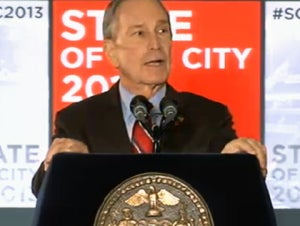Bloomberg’s State Of The City Ideas Good For Health And The Environment

A lot happened yesterday: Brooklyn Nets cheerleaders. Jay-z soundtrack. Kids dancing on stage. The new stadium at Barclays Center. Popcorn. Valentine’s Day. Mayor Bloomberg’s birthday? Yes. But also his last State of the City speech.
In his speech and a small briefing in advance, he identified recent environmental wins: clean heat’s 170 tons of soot per year gone so far, a 16 percent cut in GHG pollution since 2005, the monumental third water tunnel under city streets, new waterfront parks underway at Fresh Kills, Governors Island and Brooklyn Bridge Park.
Mindful of 320 days left in his term (this guy counts data), he announced some ideas that can get done now:
- Electric vehicles. A network of charging units citywide with 30-minute charges — one third of NYC’s taxi fleet to be electric. New York City could become a great place to charge a Tesla, a Leaf or a Volt. With traffic just behind heating oil as the main reason why some neighborhoods have unusually high pollution, that’s a good idea for health and climate. It also opens a conversation about the electric grid that extends well past his term. Will those cars run on electricity created by solar, hydro, wind, nuclear, natural gas, coal? Here’s an example of how to get it right: Pecan Street Inc.
- Recycling. Expanded recycling for plastic, including those take-out containers so familiar to New Yorkers. And – an issue that’s getting a bit of press – ridding our city of styrofoam cups used in schools, delis and restaurants. This reminds me of EDF’s work with McDonald’s many years ago, getting rid of the Styrofoam clamshell.
- Third, a citywide bike share program, to launch this summer. This could end up being one of the largest bike share programs in the world.
Equally interesting are some of the ideas not explicitly framed as “environmental,” for instance:
- A post-Sandy commitment to “rebuilding here,” on the waterfront — but doing so sustainably, in a way that “keeps the lights on” in a storm. That will take unprecedented collaboration with state and federal policy makers, tech innovation, architecture and design and efficiency finance. A first step is to make sure that federal dollars flowing in to the region after Sandy are spent in a way that helps local communities make fully informed choices about not just “where” to rebuild, but “how” to rebuild.
- And an idea that could reshape the skyline for a long time: “Midtown rezoning.” Sound boring? Could be. But imagine midtown Manhattan with buildings that are far at the forefront of resilience and clean energy – taking full advantage of the latest technologies to generate clean electricity and waste as little as possible. Could Manhattan be the next Pecan Street? This is an opportunity not yet fully-seized.
Getting these things done right will require complex policy work — and lots of engagement with neighborhoods, communities, elected officials and the private sector, across all boroughs. With that kind of engagement, we will evolve and survive any one administration, helping to keep New York at the forefront of urban sustainability worldwide.










